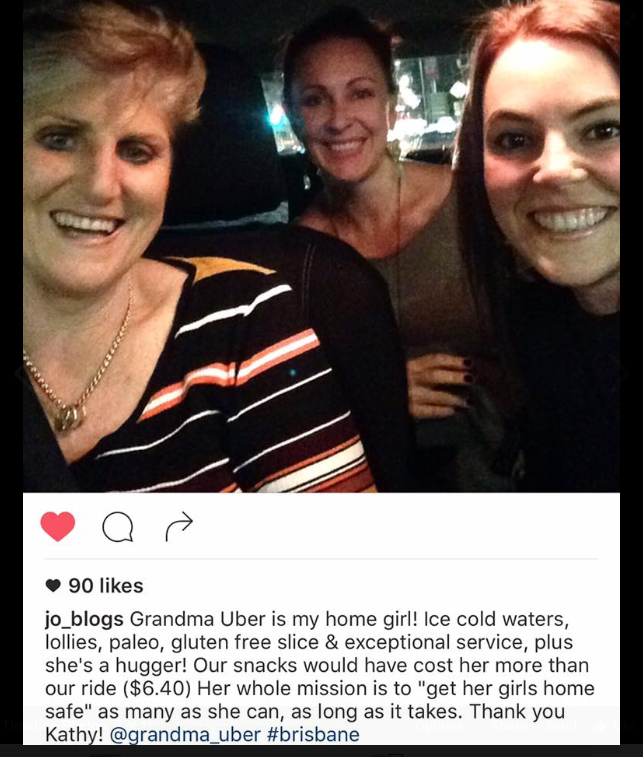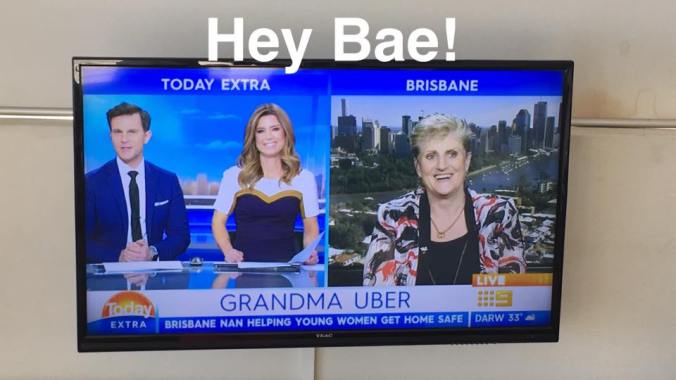by Geraldine Clarke (212248123)
Kathy Raydings is a Brisbane grandmother who was in need of a source of income after a vicious dog attack in her previous job left her struggling financially. Kathy signed up as a driver for Uber in March this year and began carving out a niche for herself driving younger women home after nights out. One customer, Amy O’Farrell started spreading the word about Kathy’s service on social media. Amy’s Instagram post gained 5,000 likes in 24 hours, including celebrity endorsements. Amy would be seen as a “influencer” in social networks according to the research of Katona, Zubcsek & Sarvary (2011, p. 1, 428).
Grandma Uber is born!
As online reviews and word of mouth spread, Kathy was quickly dubbed Grandma Uber and set up a Facebook site with this name. Kathy placed Grandma Uber signage in her vehicle and began advising customers of her roster.
Grandma Uber – a Differentiated Service
Grandma Uber is differentiating her service from other Uber drivers and competitors such as taxi drivers, through value-add offerings of her service.
For example the core offerings of a Uber trip are transport, safety and timeliness.
Iacobucci (2013, p. 71) explains how the core offerings of a product are the basics and a company is expected to get these right. However, they will know about it if they get it wrong. For example, in the U.S., Uber reported that between December 2012 and August 2015, there were 170 “legitimate” claims of sexual assault by drivers, which breaks down to 1 incident in every 3.3 million trips.

On the other hand, Iacobucci (2013, p. 71) says that value-adds are what companies can compete on.
Grandma Uber offers customers an intangible experience, including sweets and drinks, sing-a-longs, selfies, relationship advice and a caring, personal and maternal experience.
Customers are raving about this to their friends and strangers via social media, such as the following social media post.

Source: Facebook/Grandma Uber
Social Media Spreads the Word
Positive social media posts and word of mouth (WOM) has led to significant media coverage for Grandma Uber both within Australia and overseas. This backs up the claim made by Katona, Zubcsek, & Sarvary (2011 p. 426) that “marketers increasingly believe that the efficient way of using social networks for marketing relies on harnessing WOM”.
Source: Facebook/7 News Brisbane
Grandma Uber Umbrella Brand
All this publicity is leading to such demand that Kathy Raydings is recruiting other women to join Uber and “come under the Grandma Uber umbrella with my support and guidance“ (Facebook/Grandma Uber 2016).
“Umbrella branding is the practice of labeling more than one product under a single brand name” (Rasmusen 2016, p.261). In this sense Grandma Uber is a differentiated product within the Uber brand. Likewise, other women Uber drivers can come under a ‘Grandma Uber’ brand and share a “common identity” (Rasmusen 2016, p.261). According to Rasmusen (2016, p.261) “reputation can be leveraged across products via umbrella branding.”
Brand Association and Customer Engagement
Grandma Uber is developing a strong positive reputation and brand associations with her customers. Iacobucci (2013 p. 79-80) describes how it is the “intangible cognitive and emotional associations” that enable customers to connect to a brand.
Further Iacobucci (2013 p. 79-80) describes how product attributes are easy for competitors to replicate, whereas it is more difficult for competitors to replicate more abstract benefits that connect with customers on the emotional level.
Personal connection with customers is what Grandma Uber is building. Many organisations strive to gain customer engagement with their brand (Hollebeek 2011, p. 555), however this seems to have come easily for Grandma Uber. For example Grandma Uber takes selfies with customers and posts them on social media with personal messages. Customers respond with personal messages of their own and endorsements of the service.
Facebook/Grandma Uber
Grandma Uber – Personality Plus!
The Grandma Uber brand is personified in Kathy Raydings, in those women who join her and in her ‘followers’. This all serves to create a brand personality. Grandma Uber is seen as fun, caring and maternal.
Facebook/Grandma Uber
Grandma Uber as a Social Community
Iacobucci (2013 p. 80) also describes how brands can serve social functions and become the “focal point of bonding, as in so-called brand communities”.
This can be seen happening in Grandma Ubers Facebook site and in how her customers see her as a maternal figure. It is also seen in other initiatives such as the Go Fund Me Campaign site set-up by customer Amy O’Farrell this month. Amy set up the site to raise funding for a “Grandma Uber Party Bus, Grandma Uber car stickers, Grandma Uber t-shirts and a dashcam to record Sing-a-Longs.”
This demonstrates the personal connection customers have to Grandma Uber and the community that is developing around the person and the brand.
The Go Fund Me Campaign status as at 28 August 2016
What does all this mean for Uber? (And for Grandma Uber?)
The question needs to be asked as to what is the effect of the creation of a Grandma Uber brand within the Uber brand? Does this fall outside agreements between Uber and its drivers? Does it infringe on trademarks over the Uber brand?
Apart from these questions, Grandma Uber shows how a company has “limited control over how their brand is used”, even if “protective legislation” is in place.
This is especially so in the world of social media.
References
Hollebeek, L 2011, ‘Exploring customer brand engagement: definition and themes’, Journal Of Strategic Marketing, 19, 7, pp. 555-573, Business Source Complete, EBSCOhost, viewed 29 August 2016.
Iacobucci, D 2013, 2012, MM4 Marketing Management, South Western, Cengage Learning, Mason, OH, USA
Katona, Z, Zubcsek, P, & Sarvary, M 2011, ‘Network Effects and Personal Influences: The Diffusion of an Online Social Network’, Journal Of Marketing Research (JMR), 48, 3, pp. 425-443, Business Source Complete, EBSCOhost, viewed 29 August 2016.
Rasmusen, EB 2016, ‘Leveraging of Reputation through Umbrella Branding: The Implications for Market Structure’, Journal Of Economics & Management Strategy, 2, p. 261, Academic OneFile, EBSCOhost, viewed 29 August 2016.











